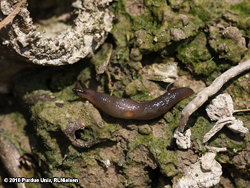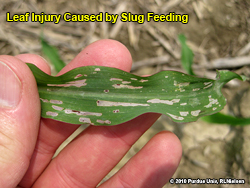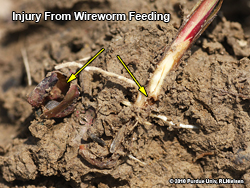2 June 2010
URL: http://www.kingcorn.org/news/articles.10/UglyCorn-0602.html
Some Ugly Ducklings Grow Up to be Ugly Ducks, Not Beautiful Swans

Looking east, a uniformly healthy field of corn.

Looking west, an ugly field. Approximately the same stage of development as the beautiful field, suggesting similar planting dates.
R.L. (Bob) Nielsen
Agronomy Dept., Purdue Univ.
West Lafayette, IN 47907-2054
Email address: rnielsen
at purdue.edu
![]() ome of the regulars uptown at the Chat 'n Chew Cafe have been griping about the article I wrote several weeks back that suggested that young corn that was looking ugly at the time would come out of it once it reached the V6 stage of development (Nielsen, 2010). It seems that everybody and his brother are still looking out their kitchen windows at fields of corn that remain stunted, yellow-green, and otherwise very uneven in their appearance. Everyone (farmers, their wives, their fathers, their landlords, their bankers) is wondering what on earth is going on with some of these fields and why these ugly ducklings are not turning into the beautiful swans that my aforementioned article suggested would happen.
ome of the regulars uptown at the Chat 'n Chew Cafe have been griping about the article I wrote several weeks back that suggested that young corn that was looking ugly at the time would come out of it once it reached the V6 stage of development (Nielsen, 2010). It seems that everybody and his brother are still looking out their kitchen windows at fields of corn that remain stunted, yellow-green, and otherwise very uneven in their appearance. Everyone (farmers, their wives, their fathers, their landlords, their bankers) is wondering what on earth is going on with some of these fields and why these ugly ducklings are not turning into the beautiful swans that my aforementioned article suggested would happen.
In all fairness, I did say in that article that "if the plants hang in there until they reach the five- to six-leaf stage", then they would likely "turn the corner" and look much better. You have to admit that, indeed, there are quite a few fields that have done just that and look great today versus several weeks ago.
Unfortunately, quite a few other fields continue to look ugly even though they are approaching V5 and beyond. The question on everyone's mind is "Why have these fields deteriorated instead of improving?" Furthermore, sometimes ugly fields are across the road from beautiful fields. What's up with that?
There is no single answer that explains why there continue to be so many "ugly duckling" fields around the state at the moment. Instead, there are multiple possibilities occurring in all possible combinations from field to field. The degree of "ugliness" is very much dependent on the timing and duration of the particular causes of the problem for any given field.
Here is a short "laundry list" of the stressors contributing to the problems early in this growing season. Mix and match them to help diagnose the combination of factors for the field(s) of your choice. Many of these stressors can be more significant in continuous corn cropping systems, especially if minimal or zero tillage were used. The negative effect of many of these stressors will be greater the younger the crop was when they occurred. Hybrids naturally differ for tolerance to these stressors, which adds to the confusion when comparing one field to another.
Finally, remember that stressed plants that have not had time to recover do not tolerate subsequent stress as well as healthy plants. Consequently, healthy fields "turn the corner" and become beautiful swans and severely stressed field "stall out" and remain ugly ducks.
Corn Crop Stressors Thus Far in 2010
- Frequent and / or heavy rain events that kept surface soils saturated for lengthy periods of time.
- Leaching of mobile nutrients, like nitrogen, below the root depth of the young corn plants.
- Several weeks of cool and cloudy weather that certainly was not optimum for photosynthesis.
- Herbicide injury due to slow corn plant metabolism during cool, cloudy weather.
- Above-ground frost damage; especially if multiple occurrences.
- Above-ground damage to blowing sand / soil particles; aka "sand blasting"; especially if multiple occurrences.
- Damage to kernels or seedlings from a number of pests including wireworms, slugs, nematodes, seedling blight, and anthracnose.
- Nitrogen tieup by soil microbes responsible for decomposing residues near the surface; especially corn following corn.
- Soil compaction from last fall's late, wet harvest; aggravates the saturated soil problem.
- Soil compaction from tillage and planting operations this spring; aggravates the saturated soil problem.
- Natural spatial variability within fields for soil drainage characteristics.
- Natural spatial variability within fields for soil color; affects early soil temperatures and seedling development.
- Tile drainage systems that are non-existent, inadequate or poorly functioning.
- Excessively low soil pH; affects early root development.
- No starter fertilizer or inadequate starter fertilizer rates; not desirable in a year like this.

Uniform appearance of corn following soybean. Same hybrid, starter fertilizer rate, and planting date as adjacent 4th-year corn field.
Related References
Faghihi, Jamal, Betsy Bower, Christian Krupke, and Virginia Ferris. 2010. Corn Nematodes. Purdue Pest & Crop Newsletter, Purdue Univ. [online]. http://extension.entm.purdue.edu/pestcrop/2010/issue4/index.html#nematode [URL accessed June 2010].
Nielsen, RL (Bob). 2007. Mitigate the Downside Risks of Corn Following Corn. Corny News Network, Purdue Univ. [online] http://www.agry.purdue.edu/ext/corn/news/timeless/CornCorn.html [URL accessed June 2010].
Nielsen, RL (Bob). 2008. A Recipe for Crappy Stands of Corn. Corny News Network, Purdue Univ. [online] http://www.kingcorn.org/news/articles.08/CrappyRecipe-0422.html [URL accessed June 2010].
Nielsen, RL (Bob). 2010. Corn and the Ugly Duckling. Corny News Network, Purdue Univ. [online] http://www.kingcorn.org/news/timeless/UglyDuckling.html [URL accessed June 2010].
Krupke, Christian & John Obermeyer. 2010. Are Slugs Sliming Your Crop? Purdue Pest & Crop Newsletter, Purdue Univ. [online ]http://extension.entm.purdue.edu/pestcrop/2010/issue8/index.html [URL accessed June 2010].
Sweets, Laura. 2010. Anthracnose in Corn. Integrated Pest & Crop Management Newsletter, Univ of Missouri [online] http://ppp.missouri.edu/newsletters/ipcm/archives/fullissue/v20n10.pdf [URL accessed June 2010].
Wise, Kiersten. 2010. Wet Soils Favor Seedling Blights in Corn and Soybean. Purdue Pest & Crop Newsletter, Purdue Univ. [online] http://extension.entm.purdue.edu/pestcrop/2010/issue8/index.html#wet [URL accessed June 2010].








